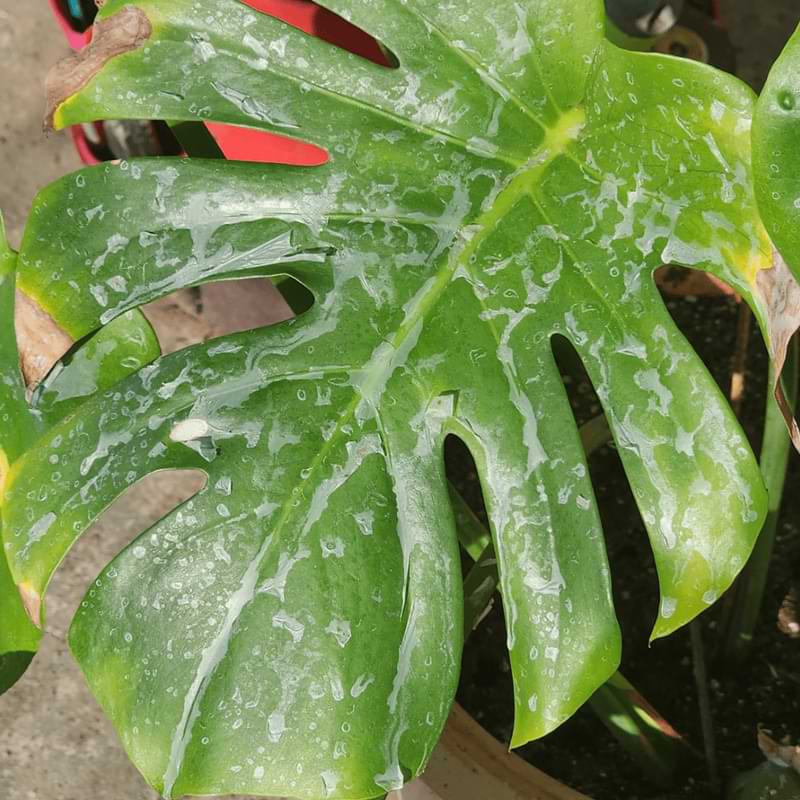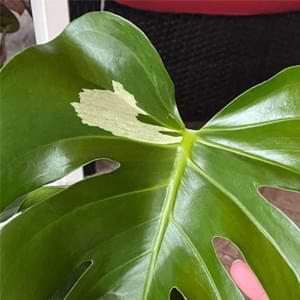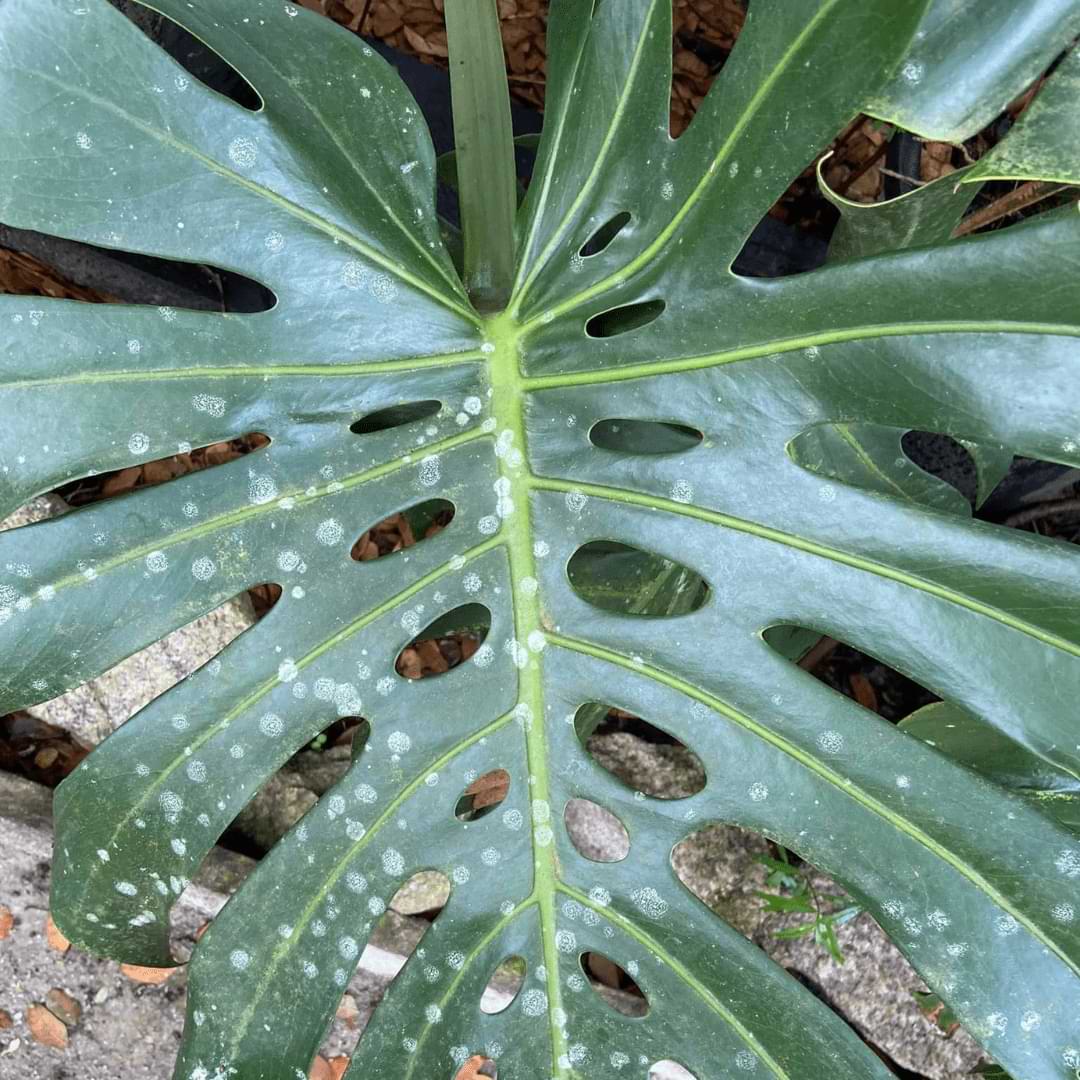Monsteras are gorgeous plant with large and lush leaves, and are making their way into many people’s homes. But what happens when those vibrant green leaves start developing mysterious white spots? Don’t worry, we’ve got the answers!
Table of Contents
Reasons Monstera Leaves Turn White
Pests, diseases, and environmental factors can all contribute to the appearance of white spots on Monstera leaves. It may be overwhelming at first to try to figure out exactly what is causing your Monstera leaves to turn white, but this guide will help you identify the reason and tell you how to fix it.
1. Pests
Pests can be a major cause of white spots on Monstera leaves. Two common culprits are thrips and mealybugs. These tiny insects feed on the plant’s sap, leaving behind small white patches or specks.
Remember to isolate any infested plants to prevent further spread within your collection. Keeping your houseplants healthy and regularly cleaning their foliage also helps deter pests from taking hold in the first place.
Thrips
Thrips are minute pests that can damage plants by puncturing their cells and sucking out the contents. They leave behind trails of silver or white spots on Monstera leaves as they move around and feed.
Mealy Bugs
Mealybugs are soft-bodied insects covered in a powdery wax-like substance. They cluster together on stems and leaf undersides, causing discoloration and white fuzziness.
To deal with both of these pests, it is important to identify them early through regular inspections of your Monstera plant. You can use organic insecticidal soaps or neem oil to control thrips and mealybugs effectively. Simply wipe down affected areas, and keep a close eye on the plant to prevent reinfestation.

2. Diseases
Diseases can wreak havoc on the health and appearance of your beloved Monstera plant. Two common diseases that can cause white spots on Monstera leaves are powdery mildew and white mold.
Powdery Mildew
Powdery mildew is a fungal infection that appears as a powdery, white substance on the leaves, stems, and even flowers of your plant. It thrives in humid conditions with poor air circulation. If left untreated, it can stunt growth and ultimately lead to leaf yellowing and drop.
White Mold
White mold is caused by another type of fungus called Sclerotinia sclerotiorum. It forms fluffy white patches on the surface of leaves and stems. Unlike powdery mildew, this disease prefers cool temperatures and high humidity levels.
Both powdery mildew and white mold spread through spores carried by wind or water droplets. To prevent their occurrence or minimize their impact:
- Ensure proper air circulation around your plants.
- Avoid overhead watering.
- Keep humidity levels in check.
- Remove any infected plant material promptly.
If your plant is affected by either of these issues, use a fungicidal treatment, and follow the directions on the bottle carefully. Remember to always monitor your Monstera closely for signs of these diseases so you can take action early if necessary!
3. Edema
Edema is one of the causes that can lead to white spots on Monstera leaves. It occurs when there is an imbalance between the water uptake and transpiration in the plant. When this happens, excess water accumulates in the cells, causing them to swell and appear white or translucent.
The most common cause of edema in Monstera plants is overwatering. When we shower our beloved plants with too much water, their roots become saturated and are unable to properly absorb oxygen. This leads to poor circulation within the plant, resulting in edema.
High humidity levels can also cause this to happen in your plant. If your Monstera resides in a space with excessive moisture, it may struggle with proper transpiration. The excess humidity can create a humid microclimate around the leaves, making it difficult for them to release moisture through stomata.
To prevent edema and its associated white spots on your Monstera leaves, it’s crucial to maintain a consistent watering schedule while allowing for adequate drainage and ensure good air circulation around your plant by providing sufficient spacing between other foliage or objects.
Treating for an edema in your plant is usually as simple as fixing the cause behind it. It should slowly go away, but if it doesn’t, then you may need to prune off the leaves with the unsightly edemas. It won’t hurt to leave them on your plant, though. Just watch carefully to ensure that the affected spots don’t begin to attract pests or diseases.
4. Nutrient Deficiencies
Nutrient deficiencies are one of the common causes of white spots on Monstera leaves. These spots can indicate that your plant is not getting the necessary nutrients it needs to thrive. Different nutrient deficiencies can manifest in different ways, but they all have one thing in common – they disrupt the normal growth and development of your Monstera.
One common nutrient deficiency that leads to white spots is iron deficiency. If your Monstera lacks iron, its leaves may develop chlorosis, which means they lose their green color and turn pale or yellowish. This can result in white patches or streaks on the foliage.
Another possible nutrient deficiency is magnesium deficiency. When your Monstera doesn’t receive enough magnesium, its older leaves may start developing yellow bands between veins, while newer growth remains green. These yellowed areas can sometimes appear as white spots.
Similarly, a calcium deficiency can also cause white spotting on Monstera leaves. Calcium plays a vital role in cell wall formation and overall plant structure. Without sufficient calcium, leaf tissue may become weakened and develop necrotic spots that eventually turn white.
To prevent these nutrient deficiencies from occurring, it’s important to provide your Monstera with a well-balanced plant food specifically formulated for indoor plants. Regularly fertilizing according to the product instructions will help ensure that your plant receives all the essential nutrients it needs to maintain healthy foliage.
5. Sun Burn
Sun Burn can be a common cause of white spots on Monstera leaves. Just like humans, plants can also get sunburned if they are exposed to too much direct sunlight. Monstera plants naturally grow under the shade of larger trees, so they are not accustomed to receiving intense and direct sunlight for long periods of time.
When Monstera plants are placed in bright, indirect light or near a window with intense sunlight, their leaves may start to develop white spots or patches. These white spots indicate damage caused by excessive exposure to sunlight.
To prevent sunburn on your Monstera plant, it is important to provide it with the right amount of light. Place your plant in an area that receives bright, indirect light or use a sheer curtain to filter out some of the intensity if it’s directly in front of a window.
White spots caused by a lack of light may or may not go away once the problem is fixed. Typically, once a spot on a leaf loses its green color, it typically doesn’t come back except in certain situations.
6. Variegation
Variegation is a fascinating phenomenon in the world of plants, and it occurs when different colors or patterns appear on the leaves. In the case of Monstera plants, variegation can result in beautiful white spots or streaks on the foliage.
Variegation is completely normal and even coveted in Monstera varieties. Sometimes, certain genes responsible for producing chlorophyll may mutate, leading to areas with reduced pigment production. This results in patches or stripes without green coloration.
Environmental factors can also play a role in variegation. For instance, insufficient light exposure can cause the plant to produce less chlorophyll and develop white spots as a result. On the other hand, excessive direct sunlight can lead to sunburn and bleaching of the leaves. More often than not, variegation is completely normal in certain Monstera varieties, and there is no need to fix it.
It is worth mentioning that while variegation is completely normal, if there isn’t enough green on the leaf to sustain the leaf, it will begin to die off faster than other less-variegated leaves. A leaf with heavy variegation will just not live as long because it has less chlorophyll.
Remember that identifying the specific cause of your Monsteras white spots is crucial for implementing effective treatment methods. Whether it’s pest control measures, adjusting watering practices, providing proper nutrition supplements, or finding an appropriate balance of light exposure—all efforts should be tailored accordingly for your unique plant baby!
White Spots On Monstera Stem
In addition to white spots on the leaves, you may also notice white spots appearing on the stem of your Monstera plant. While this is not as common as white spots on the leaves, it can still be a cause for concern.
Many of the causes listed above may also be the cause behind the white spots on your plant’s stem, but one of the more common causes is mold or mildew from over saturated soil or from moisture being trapped between a leaf stem and the main stem. Plant your Monstera in a soil mix specially formulated for Monstera varieties, and you’ll likely take care of a lot of these issues.
Keeping a close eye on your plant for changes in its appearance and overall health will allow you to catch any of these issues before they become a big problem. Remember that every plant requires individual attention based on its specific needs. Regularly inspecting your Monstera plants for any signs of distress will allow you to intervene quickly and ensure their overall health and well-being.
Caring for monstera plants is actually fun and pretty easy once you get the hang of it! Try these resources for growing the healthiest, more gorgeous monstera around!
Monstera Resource Facebook Group
More Monstera Care Articles:
The Comprehensive Guide to Monstera Albo Propagation





